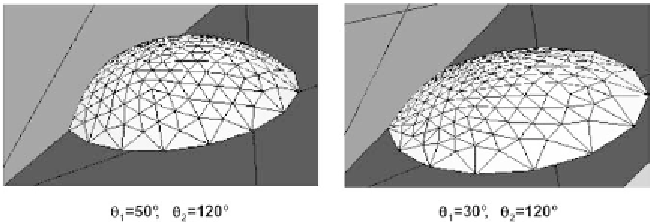Biomedical Engineering Reference
In-Depth Information
3.8.1.4 Droplet in a Wetting/Nonwetting Corner
Let us examine the case of a corner dihedral with one surface lyophilic (wetting)
and the other one lyophobic (nonwetting). It is expected that, if the contact angle
on the wetting side is small and that on the nonwetting side is large, the drop will
be positioned on the wetting side. By referring to [26], a criterion for the drop to be
positioned on the wetting side only is
θ θ π α
-
>
-
2
(3.83)
2
1
with
a
being the wedge half-angle. Relation (3.83) can be verified by numerical
simulation as shown in Figure 3.59.
3.8.1.5 Droplet in a Groove
The behavior of liquid or liquid droplets in grooves has become a subject of re-
search with the development of open microfluidics. Grooves and cusps present
the advantage of being easily accessible and easily washable and they confine the
liquid in small volumes, due to pinning of the upper edges. Seemann et al. [27] and
Lipowsky et al. [28] have observed that two parameters govern the morphology of
the liquid in a groove: (1) the aspect ratio X of the groove geometry (i.e., the ratio
of the groove depth to the groove width); and (2) the contact angle
q
of the liquid
with the solid substrate. Basically, there are three morphologies for a liquid in a
groove: filaments, wedges, and droplets. Filaments correspond to the case where
the liquid spreads in the groove, either in corners if the volume of liquid is small, or
in the whole groove if the volume of liquid is sufficient (Figure 3.60); filaments are
obtained for contact angles smaller than 45°, according to the Concus-Finn rela-
tion
q
£
π
/2 -
a
, where
a
is the corner half-angle. The liquid remains in the form of
droplets or stretched droplets if the contact angle is larger than 45°. If the volume
of liquid is small compared to the dimensions of the groove, the liquid goes to the
corners of the groove, forming wedges. For more details on these morphologies, a
complete diagram has been found by Seemann et al. [27].
3.8.1.6 Droplet on a Lyophilic Strip
In this section we present the different morphologies of a droplet sitting on a wetting
(lyophilic) band on the surface of an otherwise nonwetting (lyophobic) horizontal
Figure 3.59
Droplet in a corner with wetting and nonwetting sides. (a) The droplet stays attached
to the corner. (b) The droplet is at equilibrium on the wetting side (Surface Evolver calculation).


